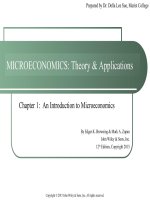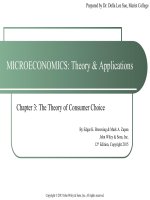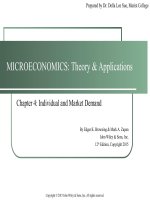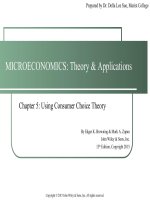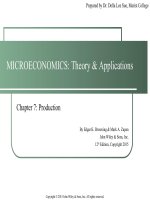MicroEconomics theory and application 12th by browning an zupan chapter 05
Bạn đang xem bản rút gọn của tài liệu. Xem và tải ngay bản đầy đủ của tài liệu tại đây (529.46 KB, 42 trang )
Prepared by Dr. Della Lee Sue, Marist College
MICROECONOMICS: Theory & Applications
Chapter 5: Using Consumer Choice Theory
By Edgar K. Browning & Mark A. Zupan
John Wiley & Sons, Inc.
13th Edition, Copyright 2015
Copyright © 2015 John Wiley & Sons, Inc. All rights reserved.
Learning Objectives
Determine how an excise subsidy affects consumer welfare
and why it results in a deadweight loss.
Examine how the public provision of a certain quantity of a
good such as education may lead to less consumption of the
good.
Analyze how a voucher program would affect the quantity
of educational services chosen by parents for their children.
(continued)
Copyright © 2015 John Wiley & Sons, Inc. All rights reserved.
2
Learning Objectives
(continued)
Explore the impact of per-bag charges versus a fixed annual
fee on the amount of trash generated by a community,
recycling, and household welfare.
Develop an intertemporal model that illuminates the
consumer’s choice to save or borrow and shows how
changes in endowment and the interest rate affect that
choice.
Understand how the theory of consumer choice can explain
what types of financial assets an individual intent on saving
for the future should purchase, or invest in.
Copyright © 2015 John Wiley & Sons, Inc. All rights reserved.
3
Determine how an excise subsidy affects consumer welfare and why it
results in a deadweight loss.
5.1 EXCISE SUBSIDIES, HEALTH
CARE, AND CONSUMER WELFARE
Copyright © 2015 John Wiley & Sons, Inc. All rights reserved.
4
Excise Subsidies, Health Care, and
Consumer Welfare
Excise subsidy – a form of subsidy in which the government
pays part of the per-unit price of a good and allows
consumers to purchase as many units as desired at the
subsidized price
Example: tax credit for a expenditures on a specific good or service
Lowers the price to the consumer or taxpayer
Copyright © 2015 John Wiley & Sons, Inc. All rights reserved.
5
Figure 5.1 - Excise versus Lump-Sum
Subsidy
Copyright © 2015 John Wiley & Sons, Inc. All rights reserved.
6
The Relative Effectiveness of a LumpSum Transfer
Lump-sum transfer – a form of subsidy in which the
government gives the consumer a cash grant to be spent in
any way the recipient wants.
Cash transfer: has an income effect
Excise subsidy: has both an income effect and a substitution effect
Consequently, consumers prefer a cash grant but they do not necessarily purchase
more of an otherwise subsidized good
Copyright © 2015 John Wiley & Sons, Inc. All rights reserved.
7
Using the Consumer Surplus Approach
Implication – The consumer could be better off with an
alternative subsidy of the same cost to the government
Deadweight loss – a measure of the aggregate loss in wellbeing resulting from output not being at the efficient level
It does NOT mean that the consumer is worse off under the
excise subsidy than with no subsidy at all.
Copyright © 2015 John Wiley & Sons, Inc. All rights reserved.
8
Figure 5.2 – Excise Subsidy Using
Consumer Surplus
Copyright © 2015 John Wiley & Sons, Inc. All rights reserved.
9
Subsidizing Consumption
The government has two ways to subsidize consumption:
Reduce the price
Provide a particular quantity of the good or service at a price below the market price
Examples:
Health insurance
Education
Garbage disposal
The Consumer’s Choice to Save or Borrow
Investor Choice
Copyright © 2015 John Wiley & Sons, Inc. All rights reserved.
10
Examine how the public provision of a certain quantity of a good such as
education may lead to less consumption of the good.
5.2 SUBSIDIZING HEALTH
INSURANCE: OBAMACARE
Copyright © 2015 John Wiley & Sons, Inc. All rights reserved.
11
Subsidizing Health Insurance: Obamacare
Patient Protection and Affordable Care Act, enacted March
23, 2011
Major goal: reduce the number of people without health
insurance
Program components:
subsidization of individual health insurance purchases (discussed here)
Expansion of existing government welfare programs
Copyright © 2015 John Wiley & Sons, Inc. All rights reserved.
12
The Basics of Obamacare
Health insurance policy offering specific coverage
(determined by the government) to those eligible for the
subsidy
Regressive (subsidy decreases as income increases)
Following slides: application of consumer choice theory to
examine the effects of subsidization
Copyright © 2015 John Wiley & Sons, Inc. All rights reserved.
13
Figure 5.3 – Health Insurance Subsidy’s
Effect on the Budget Line
Copyright © 2015 John Wiley & Sons, Inc. All rights reserved.
14
Bringing in Preferences
Two alternatives
Subsidy – uninsured recipient is left equally well off with subsidy
Unrestricted cash transfer – recipient is better off with monetarily equivalent cash
transfer
Outcome: deadweight loss (inefficiency)
Considerations in ObamaCare legislation
Mandate to require health insurance policy
Pay a fine instead of participation in program
Copyright © 2015 John Wiley & Sons, Inc. All rights reserved.
15
Figure 5.4 – The Optimal Consumption
Choice and the Resultant Deadweight Loss
Copyright © 2015 John Wiley & Sons, Inc. All rights reserved.
16
Figure 5.5 - A Case Where Mandated
Insurance Harms Subsidy Recipients
Copyright © 2015 John Wiley & Sons, Inc. All rights reserved.
17
Analyze how a voucher program would affect the quantity of educational
services chosen by parents for their children.
5.3 PUBLIC SCHOOLS AND THE
VOUCHER PROPOSAL
Copyright © 2015 John Wiley & Sons, Inc. All rights reserved.
18
Public Schools and the Voucher
Proposal
Alternative form of subsidy: government offers a specific
quantity of a good at a cost that is below market price.
Example: public school voucher
Voucher program: a subsidy in which parents receive
vouchers that can be used to purchase education at any
school of their choice
Copyright © 2015 John Wiley & Sons, Inc. All rights reserved.
19
Using Consumer Choice Theory to
Analyze Voucher Proposals
Expected outcomes
Some families purchase a larger quantity of educational services.
Some families purchase a type of education that they view as superior.
Unintended consequences
Competition between public and private schools could lead to improved quality of
education in both schools.
The education system could become more segmented.
Copyright © 2015 John Wiley & Sons, Inc. All rights reserved.
20
Figure 5.6 – Fixed-Quantity Subsidy:
Education
Copyright © 2015 John Wiley & Sons, Inc. All rights reserved.
21
Explore the impact of per-bag charges versus a fixed annual fee on the
amount of trash generated by a community, recycling, and household
welfare.
5.4 PAYING FOR GARBAGE
Copyright © 2015 John Wiley & Sons, Inc. All rights reserved.
22
Paying for Garbage
Original trash collection plan: residents pay a fixed annual
price for pick up
Those with less garbage subsidized those with more garbage
New plan: residents purchase garbage collection bags at a
price that exceeds their cost, which generates a net revenue
that is used to finance garbage collection services
Each household pays cost of own trash disposal.
Everyone has an incentive to reduce amount of trash generated.
Copyright © 2015 John Wiley & Sons, Inc. All rights reserved.
23
Figure 5.7 - Consumer Choice: Garbage
Disposal
Copyright © 2015 John Wiley & Sons, Inc. All rights reserved.
24
Does Everyone Benefit?
Price-per-bag system:
Each household has an incentive to reduce the amount of garbage generated so
everyone gains.
Households with less than the average amount of trash gain .
BUT since the subsidy to the heavy users is removed, those who generate more than
the average amount of trash lose.
Copyright © 2015 John Wiley & Sons, Inc. All rights reserved.
25


